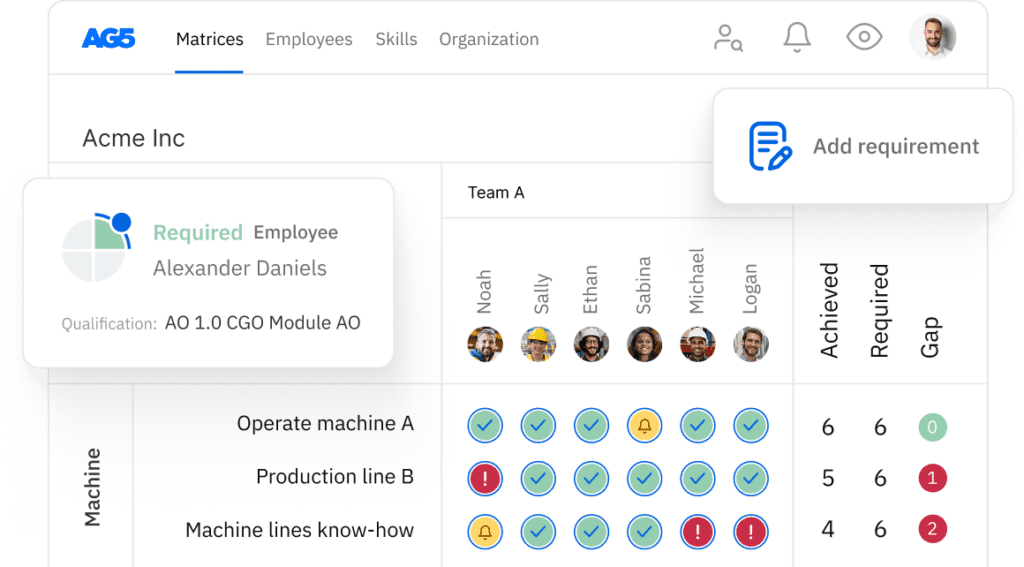Skills management in Excel vs. AG5: Everything you need to know
In this article, we will dive deeper into the challenges of Excel vs. AG5 – and explore how AG5 offers a specialised solution for regulated industries.
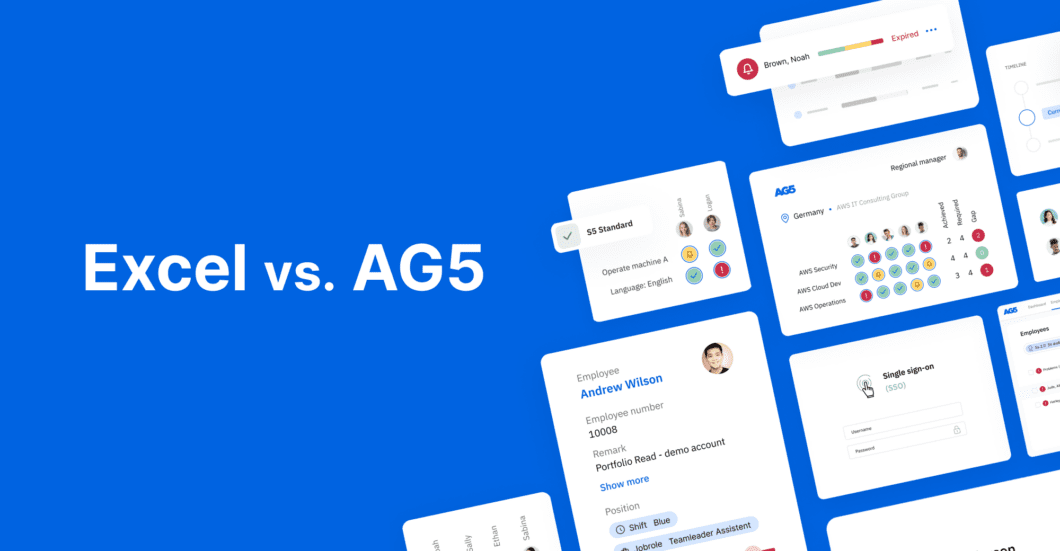
All of our customers use Excel – even after onboarding with AG5. As we all know, the software is a powerful-yet-simple tool that allows us to quickly collect and organize data.
However, our customers have fully stopped using Excel for skills management purposes.
Here’s why:
- Their skills management outgrew Excel because they had to manage increasingly more data within the same Excel file.
- They experience the typical Excel challenges that many other Excel users experience when the amount of data increases.
- They experienced challenges in Excel when updating their employees’ skills after training.
- While updating the skills in their Excel skills matrices, they face challenges in tracking historical data.
- They face a challenge in automating their skills management based on their employees’ training requirements.
All of the above are examples of challenges team managers experience while managing their employees’ skills in Excel.
In this article, we will dive deeper into the challenges of Excel vs. AG5 – and explore how AG5 offers effective resolutions.
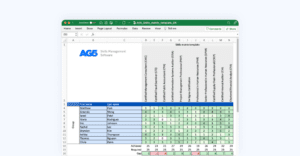
Managing employees’ skills in Excel – before AG5Copied
One of the most common reasons our customers began using Excel for skills management is because they were confronted with challenges related to:
- Quality
- Production
- Turnover
- Regulatory challenges
Of course, a critical part of resolving these challenges relates to a company’s employees.
Employees must produce high-quality products or services aligned with quality and regulatory standards. To do so, it is critical to understand how qualified your employees are. This is achieved with a simple skills matrix, on which you can plot your employees against the required skills they need to do their jobs. For this, managers often initially resort to Excel, which is entirely understandable – it is easy, quick, and familiar.
Using Excel, managers can quickly plot their employees and the required skills in a matrix format to assess individual qualifications. In addition to the skills matrix, they often create a folder structure to document employees’ certifications and training, as this can’t be part of their Excel skills matrix.
At first, this is easy to maintain. However, over time, the managers who started these Excel sheets began experiencing skills management pain points. The first and biggest among them is that they constantly need to update the skills, employee, and training data in Excel. More on this in the next section.
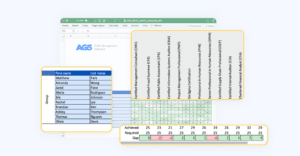
Updating skills, employee, and training data: Excel vs. AG5Copied
Whenever there is employee turnover, shift or role changes, or employees go on leave, the skills matrix needs to be updated. Otherwise, it will become outdated. Second, whenever there are new quality or regulatory requirements for your employees, managers need to update their skills matrix. They’ll also need to update it whenever there is a new version of a standard operating procedure. If not (and again), managers will have an inaccurate skills matrix.
Finally, whenever employees are given new or refresher training, the manager must update the skills matrix to reflect it. However, managers must also track historical data because of regulatory or audit requirements.
To do so, they create complex folder structures to manage all the sign-off training forms and certifications. These updates become increasingly challenging when there is:
- High turnover
- Constant updates to training requirements
- Constant updates to training content
- Continuous employee training
We often see that many of our customers have copied their old Excel skills matrices in separate tabs to keep track of training – or they have made complex art pieces of their skills matrix to manage these updates. Within this complexity, they have also created more complex folder structures to manage all of their signed training documents and certificates.
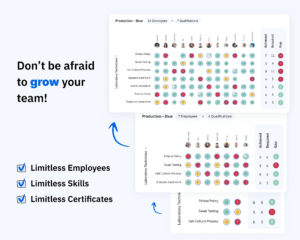
AG5 customers are relieved they no longer have to worry about their Excel sheets breaking down because of employee, training, or training requirement updates
Our software connects with HR systems – ensuring up-to-date employee data in AG5 – as well as with LMS systems, which makes all training or SOPs readily available. These integrations allow managers to easily define complex skill requirements. Once in AG5, you can specify requirements such as:
- Role
- Concurrent role
- Machine
- Line
- Workstation
Whenever a new employee is synchronized from the HR system, this will be automatically reflected in the manager’s skills matrix. This will also happen whenever the manager or a trainer provides training. In these cases, the employee must sign a form or receive a certificate that can be added to AG5 when submitting their training.
This eliminates the need to manage complex folder structures separately for all certificates or forms.
These capabilities allow managers to stop managing employee skills in Excel skills matrices without fear of losing – using out-of-date or inaccurate – data.
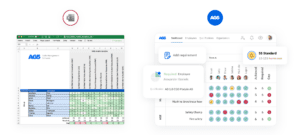
Managing skills gaps: Excel vs. AG5Copied
Excel is excellent at highlighting gaps within a given dataset – especially if you have an excellent skills matrix.
Using it, you can quickly highlight the skills gaps of employees with colors, text, or icons. You could use this skills matrix to:
- Identify who needs training
- Determine who needs to be fully qualified to plan your training programs
- Develop your budget for next year based on training needs
- Plan for replacement or succession in case of a leave of absence or retirement
This is all possible with an Excel skill matrix – assuming you have a small team and only a few changes in training, employees, or skills data.
In reality, however, it becomes quite a challenge to manage skills gaps quickly when teams grow, groups have high turnover, or there are a great deal of training changes.
That begs the following questions:
- How do managers understand the skills gaps when they have complex Excel skills matrices?
- How do they avoid production, quality, safety, or regulatory issues when employees need to be regularly retrained?
- How can managers quickly find an expert to replace another expert in an organization of hundreds or thousands of employees, who all have specialized training requirements?
All of the above relates to the intelligence part of skills management, which doesn’t exist in Excel spreadsheets. Instead, managers often resort to manual analysis, spending a great deal of valuable time to avoid issues and ensure production continuity.
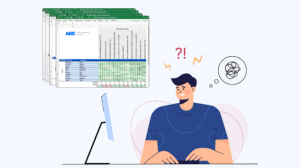
These are the challenges we see in a lot of organizations. These are crucial questions to ensure quality, safety, compliance, and production continuity.
With this in mind, AG5 has built an intelligent capability that allows managers to manage skill gaps more efficiently.
Our Expert Finder feature, Requirements functionality, and Alert List enable managers to solve such frustrations because skills management goes well beyond a simple skills matrix.
Organizations must manage skills more effectively and efficiently because of:
- Regulatory requirements
- Scalability reasons
- Quality requirements
- Production standards
- And much more
AG5’s functionalities allow them to configure their skills management strategy to ensure they are promptly informed whenever employees need training.
Using AG5, managers can:
- Find experts to replace employees to avoid production delays or quality issues
- Configure the system to ensure employees are not working unqualified to avoid compliance issues
- Work to efficiently and effectively manage skills while focusing on creating value for their customers
In our next webinar, we will show an example of an Excel sheet compared to our skills management platform, spotlighting the practical benefits of AG5 in real time.
Sign up for the webinar today to grab a front row seat to see what you just read in action – as well as the chance to ask any questions you may have. We hope to see you there!

Simplify skills management with a chat
Curious about AG5? Let’s talk. Book a commitment-free intro call. Whether you’re considering or just curious about what AG5 has to offer. If we click, we’ll plan a detailed demo, tailored for you.
Why book an intro call?
- Understand your challenges: Your situation is unique. We get it.
- Explore possibilities: See how AG5 fits your goals.
- Next steps: Ready to dive deeper? Let’s schedule a demo.
Ready to explore a smarter way to manage skills? Click below to select a convenient time for you.

